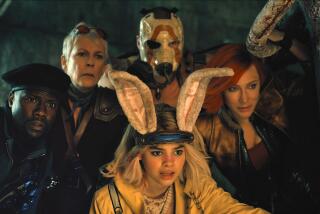MOVIE REVIEW : ‘Badlands’ Peers Into the Abyss : Cal State Fullerton will screen Terrence Malick’s first feature, about the emotional vacancy of a killer and his companion.
- Share via
FULLERTON — Terrence Malick’s “Badlands,” presented tonight at Cal State Fullerton in a two-day salute to the filmmaker, is one of the better attempts to put a face on the moral and emotional vacancy that can lead to murder.
In this, Malick’s first feature (the American Film Institute graduate wrote, directed and produced), he loosely retells the story of Charles Starkweather, a young dropout who went on a murder tear through Nebraska during the late ‘50s (a story that will get a retelling next month as the ABC-TV movie “Murder in the Heartland”). The names have been changed, as well as a few events, but it’s Starkweather’s tale.
Martin Sheen plays Kit Carruthers in the 1973 movie, which screens at the UC Titan Theatre (Malick’s “Days of Heaven” is set for Friday night). The reticent Kit looks like a standard-issue nobody, a garbage collector with a passing resemblance to James Dean. It’s his one remarkable feature, and he cultivates the connection with an unsettling passion.
By affecting Dean’s vulnerable-cool mannerisms, Kit finds a persona that suits him. We know it’s not him, and we never know exactly what he is, but that’s part of Malick’s contention: These sociopaths are empty and unreal and near impossible for us to figure out.
Sissy Spacek’s Holly Sargis, a know-nothing 15-year-old, thinks she understands Kit. To her, that blank face doesn’t hint of a missing person, only a fellow traveler on the confused streets of adolescence. It doesn’t take much persuading for Holly to follow Kit into the Badlands, even after the violence he inflicts on her father (Warren Oates) and their home.
That scene and several others in which Kit moves from one murder to the next are presented by Malick and cinematographers Tak Fujimoto, Brian Probyn and Steven Larner in a detached style. There’s a deliberate lifelessness to the picture that underscores Kit and Holly’s vapidity and gives their violence a queasy realism.
*
Malick is pretty good at not taking sides, but he does lapse into heroic reveries every now and then. At times, when the camera wraps the couple in a sympathetic, almost romantic caress (watch the scene where they dance at night under headlights) Malick finds something of a counterculture defiance in their nihilism. This “Bonnie and Clyde” sentimentality weakens his movie.
But whether always intentional, Kit and Holly finally register as wastes. In the film’s denouement, Malick seems to condemn them for not accepting responsibility for their acts.
“Badlands” was obviously important for Malick, but it also helped Spacek and Sheen’s reputations. Both know what’s expected of them--to really project no there there in Kit and Holly--and do so without acting-class flourishes. In some ways, Spacek has the harder job, to hint at an incipient womanliness in the baby-doll Holly, but she pulls it off.
Malick’s naturally austere style is even more evident in “Days of Heaven,” a period piece about a love triangle set in the Texas Panhandle near the turn of the century. Often described as having the quiet integrity of a European film, the 1978 release features Richard Gere, Sam Shepard and Brooke Adams early in their careers.
* Terrence Malick’s “Badlands” will be shown tonight, and his “Days of Heaven” screens Friday. Both films will be offered at 8 and 10 p.m. at Cal State Fullerton’s UC Titan Theatre, 800 N. State College Blvd., Fullerton. Free. (714) 773-3501.
More to Read
Only good movies
Get the Indie Focus newsletter, Mark Olsen's weekly guide to the world of cinema.
You may occasionally receive promotional content from the Los Angeles Times.









